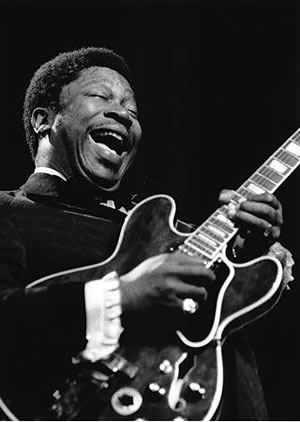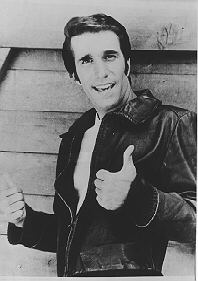Today I’m going to expose what I consider the most pervasive and insidious bit of misinformation plaguing modern society. No, it’s not that Columbus didn’t discover America. It doesn’t have anything to do with racism, the environment, or politics.
It’s about thumb placement. That’s right folks, Thumb, with a capitol T, that rhymes with C, that stands for CONSPIRACY!
Open Hal Leonard Guitar Method Book 1, a popular starter book for acoustic and electric guitar players, to page 4, and you’ll read:
Place the thumb in back of the neck roughly opposite the 2nd finger. Avoid gripping the neck like a baseball bat with the palm touching the back of the neck.Hal Leonard
Now consider these photos of Eric Clapton and BB King:


Eric and BB are two of my most promising students, but it can be SO frustrating sometimes. Look at those thumbs! I keep referring them back to Hal Leonard Guitar Method Book 1, but they never seem to learn.
Seriously, it’s not just Hal Leonard that teaches students to keep the thumb behind the neck–all classical guitar instruction books, and many folk/rock books teach this. With a few exceptions, classical guitar is best played with the thumb behind the neck, so I have no problem with Andres Segovia and Co. But in the world of acoustic and electric guitars, these books are out of touch with reality. Don’t their authors see live music? Maybe they’re too busy answering emails from confused and frustrated readers.
The truth is, sometimes you put your thumb behind the neck, and sometimes you use the “baseball bat” grip. Here are some guidelines for thumb placement:
Thumb Behind Neck
How to
Put your thumb on the back of the neck at the fattest part, roughly behind the fret where the second finger is.
When to
- Playing most classical music – Having the thumb behind the neck enables you to really arch your fingers, which is necessary when playing on classical guitars, which have higher action than acoustics and electrics. Also, usually you’re fingerpicking, so there’s no need to use the thumb for muting the 6th string (explained below).
- Playing barre chords – These require a lot of pressure, so you want the thumb and fingers to act like a clamp.
- Spreading your fingers – It’s impossible to spread them otherwise. Check out Eddie, his thumb squarely behind the neck, his fingers spanning five frets:

(Incidentally, Mr. Van Halen’s expression should not be confused with the “Blues Face” on Mr. King and Mr. Clapton above. Mr. Van Halen is exhibiting a similar expression known as the “I should never have switched hairdressers” face.)
Baseball Bat Grip
How to
Cradle the neck in the skin between the thumb and forefinger or in the entire palm of your hand, depending on what you’re playing
When to
- When you need to mute the 6th string with your thumb – Many open chords (most variations of A, C, and D’s, for example) sound best if you don’t play the 6th string. Often, guitar instruction books recommend that you avoid the 6th string when you strum these chords, which is almost impossible and usually ends up sounding wimpy anyway. How are you going to do a Pete Townsend windmill if you’re trying to miss one of the strings?
- When you’re bending strings – You get better leverage.
- When you don’t need your thumb somewhere else – The baseball grip is simply more comfortable because you don’t have to bend your wrist as much.
- When you’re using your guitar as a baseball bat—The baseball bat grip is firmer than the thumb-behind-neck grip, and as every guitar player knows, if you throw your guitar, intentionally or unintentionally, you’re “out.”
Sincerely,
Arthur Fonzerelli
Chairman
Department of Thumb Placement Correction


Comments 41
Great post, this part of technique always confused me, as far as im concerned if somehting feels wrong it usually is, though obviously this is different for everyone, but baseball grip works for me!
AMEN!
what a great blog! i’m so glad you left a comment on mine. so you’re in seattle, i’ll be at lewis and clark college in portland! not tooo far to connect, if need be. if you don’t mind i’m going to continue reading other interesting posts (yes, i play guitar… and love it.. and will now be a little more thumb conscious!)
you’re doing good work in the world rob,
Jodi
Thanks, Jodi! I’m enjoying “Believe Me” on your website right now. Great wandering, playful melody.
hey did you really teach those famous people. yeah i play bass and i find it a bad habit that i put my thumb to the side instead of putting it behind my second finger.
No Danielle, just kidding. I didn’t even make up the joke–I stole it from my favorite guitar instruction book author. What a fraud! 🙂
Yeah, the thumb should not go to the side. I nag my students about that a lot.
This post has been removed by the author.
hey rob, thanx for commenting. i checked out ur stuff and it’s helped. i’ve been playing for a lil over a year now, and have been trying to get a band together (no luck yet, all my members r goin to college). i’m a big punk rock/ alt. rock guy. Breaking Benjamin and Green Day r my favs. i’ll keep checkin back to c what u’ve got and if u have time, keep checking out my space for more stuff too…
“The” Andrew Neill
wow…thanks for posting on my site…your site looks like it is going to be very helpful to me…i have just breifly browsed it but have bookmarked it so i can take a closer look. i look forward to learning your tips.
Rachel @ http://www.binaryspeaking.blogspot.com
HIYA ROB! wassup? u sure have a gr8 blog here!! will definitley add u as one of my blog buddies. learning guitar just got simpler. thx. will visit ur blog again. take care.
Yeah this is interesting reading. I’d like to point out that both BB and Eric are blues guys, and in both of those pictures you posted, they are going for the big blues bend. In fact, BB has that rediculous smile and the full step bend that says “I’m already there”, and Eric is well on his way. He’s got his head back, and he’s getting ready to make a funny face. When doing full step blues bends with vibrato, you have to have that kind of anchor from the thumb.
Eddie Van Halen on the other hand, while doing his arpeggio thing with the finger style, has a thumb that us no where to be seen. In other words, thumb placement depends on what you are doing.
I have found that students who have their thumb wrapped up around the top of the neck have problems with freedom of movement for chord changes.To really get those tough chords down, you need full extension of the fingers over the fretboard. If the thumb is over the top of the fretboard that’s not easy. So I suggest relaxing that thumb, use it as a guide and not a thumbscrew. Keep the wrist straight and parallel to the fret board, with four fingers extended at least from the big joint over the strings.
When playing violin or classical vibrato, the thumb isn’t needed at all. When playing rock and roll vibrato you need a relaxed thumb so you can use that wrist. When playing full step bends with vibrato, you need that thumb as an anchor for that full arm vibrato.
Just my opinion. There is LOTS more to this.
Hi Everyone,
I’ve been getting so much interesting feedback about this post, here and by email. The subject’s come up several times in my lessons, too, as a result of all this discussion.
For instance, I was teaching Jack Johnson’s “Do You Remember” today, which has a cool little flatpicking-style part to it that requires quick single-note melodies sprinkled among strumming. My student was strumming and picking from the elbow, and was having a terrible time hitting the right strings. I did what I often do when I’m stumped–I played the song myself and watched how I do it (there’s so much that we do as guitarists that we’re not aware of until we have to teach it), and sure enough, I was strumming and picking from the wrist, my forearm almost motionless. I was reminded of your post, Dave A., and summarized what you’d said for my student.
So thanks, Dave!
You’re very welcome.
And thank you for the Song Charts on your site. Very helpful indeed.
I’ll keep checking this out from time to time. It’s always helpful to learn from other teachers.
I really like your site… it makes me laugh while I am getting new practicing ideas and stuff in my head. I know every major and minor scale from pentatonic to blues but I am having troubles improvising. If you even still update this site, I would love to see some good improvisation lick examples (long extended ones too). Send me an email if you ever do ^_^ I’ve been playing for a while and I am self taught, and though some concepts are easy and quick for me to learn, some I just can’t figure out on my own.
Hey James,
Glad to hear you’re enjoying the site! I’m hoping to add a supplement to this article in the next few months with some blues licks. Make sure to leave your email so that I can get in touch with you.
I have a different viewpoint on the thumb issue. Keeping your thumb up over the neck for the majority of your playing time constrains your ability to stretch and play in position (1 finger to a fret). It can also send your wrist into an unhealthy position. Having a consistent, healthy position allows you to play more effortlessly and to play more accurately. While it is true that you may use your thumb to occassionally play a bass note on the 6th string, I don’t think you should pursue this position. By the way, most people are not Clapton or King. Use the technique that is the healthiest and will actually help you.
Hi Candice,
My experience has been that having my thumb over the top of the neck is a lot easier on my wrist–there’s less bend, the tendons run more smoothly over the back of my hand, and my forearm muscles feel more loose. What do you mean by “sending your wrist into an unhealthy position”?
Thanks for joining the conversation–I’m always looking for ways to refine my students’ (and my own) technique.
I not only have very small hands, but I have a rare bone/joint disorder that causes arthritis and joint degeneration. Until a few years ago, it only effected the joints in my lower body… but recently the shoulders have broken down (have to be replaced some day) and I apparently have nerves being pinched as I play. So… certain chords have become difficult and painful to play. Incorporating my thumb to cover the low E string, seems to relax my hand and arm… though I only need it now and then (like on Croce’s “Photograph’s and Memories”) the thumb comes in very, very… handy. Sorry!
Great blog and I can not agree more….however sometimes shortcuts are used even by the greats and then sometimes not. But I do know if you keep yourself in the habit of doing it right it becomes natural to do it that way. But again on the other side of the coin if you get use to doing it with shortcuts, it gets to feel natural that way. Guess you end up going by if it is good or not…
Hello from Portugal!
Just wanted, no no no, needed to transmit my pleasure on reading this blog!
I’ve been trying to learn how to play the acoustic guitar for about 5 years but no success because of no practice but I surely think that this Golden Blog will get me through!
Way to go! This is public service!
Cool, Ricardo! Thanks for taking the time to write.
Great post. I actually have a youtube video posted of me showing some basic guitar techniques and some person left a comment saying that i am holding the guitar wrong (i was using “baseball bat” grip) and that i should not be giving lessons if i can’t hold the guitar right. Needless to say this ignorant comment upset me. So i replied by saying there is no “right” or “wrong” way to do something as long as the desired result is produced. I wonder if this guy would tell hendrix it is wrong to play a righty guitar if you’re a lefty. Now i’m no hendrix, but i think the point is clear…
At last I know that comfortable is best when the thumb is concerned. I am a new-comer to the world of guitar, so at the moment sound more like Jimmy Saville than Jimi Hedrix, however now I know how to position my thumb things may start moving again.
Thanks
Could it be my thumb positioning that’s creating a lot of wrist pain for me? I’m playing a lot more barre chords, now, and my thumb seems to want to move sideward.
I’m going to be the voice of dissent here. aside from occasionally muting or fretting the low E string for certain chords, i dont see any reason to put your thumb over the neck. all the professionals you could cite to prove me wrong all have one thing in common. they all have gigantic hands, so dont give me the ‘jimi did it and he was the greatest’ argument. look at the picture of clapton with his thumb over the neck and you’ll see that the bottom of the finger board is lined up with where his palm ends and his fingers begin. if you can maintain this finger position with your thumb over the neck then by all means go for it, but younger students of the guitar or people with naturally smaller hands (such as myself) should stay away from this possibly detrimental technique. which brings me to my next point. the idea that having your thumb over the top of the neck gives more leverage to bends might make sense, but you dont really need a whole lot of leverage to begin with (its just bending…). in addition, i’ve seen many young guitar players (with smaller hands)with their thumbs permanently affixed over the tops of their necks bend the b or e strings and fall slightly short of the target note, which to me is one of the most disgusting sounds that can come out of a guitar. in conclusion, you can show me a million pictures of b.b. king and warren haynes and eric clapton, and my response will be ‘well are you eric clapton?’
Hey Ed,
Thanks for your input. What’s detrimental about the thumb placement I recommended? The more I learn about ergonomics, the more I’m learning that bending the wrist is BAD! Unless you’re playing in classical guitar position, putting the thumb behind the neck will force most people’s wrist to bend…
Rob
Pingback: Thy Wilbury Done - THOMAS HIGGS
Hi! I learned the baseball bat grip by myself.
When I started playing guitar, stantardard thumb position suited ok for me and I couldn’t imagine how did EC used the thumb (bb grip wasn’t comfortable).
But then I started to realize that with bb grip I played faster easily because my fingers didn’t have to arch so much and sliding up and down was softer and more precise.So I finally played with bb grip.
Don’t you use the thumb also for pressing the 6th string instead of only muting? I mean, when I play G with barre on the 3rd fret: I use the thumb to press 3rd fret 6th string and index finger for the 3rd fret on 1st and 2nd strings.
Bye
PS: I play blues with a classical guitar (yes, it doesn’t sound very bluesy) , but baseball bat grip suits very well.
Actually, for those of you who think it’s just the famous guys with big hands who can play with their thumb over the neck, watch any music video from the sixties to the eighties. Almost always, the guitarist has their thumb over the neck. I have small hands and I personally think putting my thumb over the neck gives me more freedom, plus the benefit of muting the A string, which I think mucks up harmonies sometimes. Of course, for stuff like full bar chords, I need to put my thumb behind the neck. But I don’t like how they sound anyway.
Ok, so this Segovia fella thinks that BB King, Eric Clapton, Keith Richards, Buddy Guy, Jeff Beck, Jimmy Page, Ronnie Wood, Mick Taylor, Mark Knopfler, Jimi Hendrix, John Lennon, Carlos Santana and jeese what else have I missed all are bad guitarists? Ha…
Yes mate, they’re all bad guitarists…… both Jimmy and Jimi are the worst… xD
Great post!
Not to mention John Mayer and Stevie Ray. Check out JM on this clip: http://www.youtube.com/watch?v=UQSGa8nZs8g&NR=1
He’s got the “Thumb Over the Top” grip mastered!!!
This grip free’s up the the pinky and sometimes index fingers for the all the hammer-ons and pull-offs that give these songs such unique character and depth! This style started back with Curtis Mayfield.
I have recenlty developed and issue with my left thumb while fretting or playing guitar. As I am playing , my thumb on the back of the neck, i feel pain, like the tendon on the flesh/palm side that touches the neck is rolling over itself when I fret the notes/chords. Have you heard of this and any suggestions? Please!
Glen
Thanks for this post. As a beginning guitar player its hard to ignore the misinformation when you’re being told to develop good habits early on. Thanks for the validation and the explanation.
LOVE IT!! I’ve been a thumb placement non-conformist for years!! If it feels right and rings true play it the way you want to!!
As far as I’m concerned, rules are made to be broken. So giving me rules just makes me want to flip you the bird, and go my own way. Just as EVH said, “there are no rules in music.” I never worry about where my thumb is. It changes depending on what I’m doing and where I am on the neck. I’ve been playing for 30 years and I’m not about to change now. It’s personal and it’s individual. I’ve seen Steve Vai break your rules, but he has gigantic hands. In the immortal words of Frank Zappa…Shut up, ‘n play yer guitar.
Hey, Rob.
By the dates of the replies I’ve read above, I hope you’re still reading these posts. Anyway, Love the tips that show up in my email. At this point in my guitar playing career, every tip helps. I enjoy the humor you put along the way. This one on thumb placement is a good one. I purchased the Steve Krenz Learn and Master Legacy series. He’s a great guy, but he also preaches keeping your thumb firmly behind the neck. I tried to stay true to that at first, but I eventually evolved to what came more natural to what I was playing. Trying to get better every day. Thanks for the help!
Author
I am definitely reading! So funny that you’ve encountered another militant thumb-behind-the-neck teacher. Good for you for developing technique that makes sense to you. Thanks so much for writing.
Hi Rob,
Thank you for your wise advices (“conseils avisés” in french) and for the fun you bring in my “foggy” road to guitar’s glory! That’s like a “bridge over troubled water”! Concerning my thumb, I didn’t know there was a trouble with guitar, (so you give me the opportunity to think about it), but I know that thumb is the main finger when playing traditional harp in my country, among all for the left hand, if you are right-handed person. That’s my case. The thumb keeps the rhythm in a tempo that is often very quick (and accelerated) during his long time playing (maybe three nights!), and the musician must keep its thumb up to repeat the “ostinato” (melodic pattern). No way to let your thumb fails!
Hi Rob,
Just to tell you that Obiang Ludovic Ludovic and Akom are the same person. Obiang seemed to heavy to bear so I complain to your computer which agreed the substitution. Let the robots rule the world !
Also while you have your thumb hooked around it is in a great place for getting the F# on the E string for a cool D/F# chord